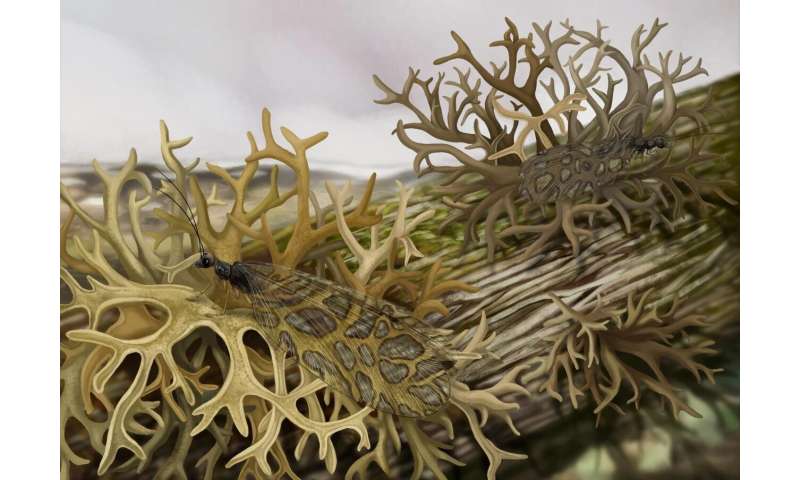
Presumably to avoid getting eaten:
The study suggests that the Jurassic moth lacewing Lichenipolystoechotes mimicked the fossil lichen Daohugouthallus to help conceal itself from predators. This interaction predates modern lichen-insect associations by 165 million years, indicating that the lichen-insect mimicry (or ‘mimesis’) system was well established during the mid-Mesozoic period and provided lacewings with highly-honed survival strategies.
Animals sometimes mimic other organisms or use camouflage to deceive predators. Lichens, which consist of a fungus and alga living in close proximity, sometimes have a plant-like appearance and are occasionally mimicked by modern animals and insects. One of the most well-known cases of a lichen-insect association is when the peppered moth acquired a mutation that turned it black during the Industrial Revolution in Britain, allowing the moth to blend in with tree trunks and lichen darkened by soot.
“As lichen models are almost absent in the fossil record of mimesis, it is still unclear as to when and how the mimicry association between lichen and insect first arose,” explains lead author Hui Fang, a PhD student at the College of Life Sciences and Academy for Multidisciplinary Studies, Capital Normal University, Beijing, China. “The key to answer this question is to find early examples of a lichen-like insect and a co-occuring lichen fossil.”
eLife, “Earliest fossil evidence of an insect lichen mimic” at ScienceDaily
Paper. (open access)
Whoever wrote the media release was very, very light on the Darwinblather.
Mind you, claiming that it all happened via endless iterations of natural selection acting on random mutations wears a bit thin when the time Darwinians thought they had has been sharply reduced.
“Our findings indicate that a micro-ecosystem consisting of lichens and insects existed 165 million years ago in Northeastern China,” concludes senior author Yongjie Wang, Associated Professor at the College of Life Sciences and Academy for Multidisciplinary Studies, Capital Normal University, Beijing. “This adds to our current understanding of the interactions between insects and their surroundings in the Mesozoic Era, and implies that there are many more interesting insect relationships awaiting discovery.”
eLife, “Scientists discover earliest fossil evidence of an insect lichen mimic” at Phys.org